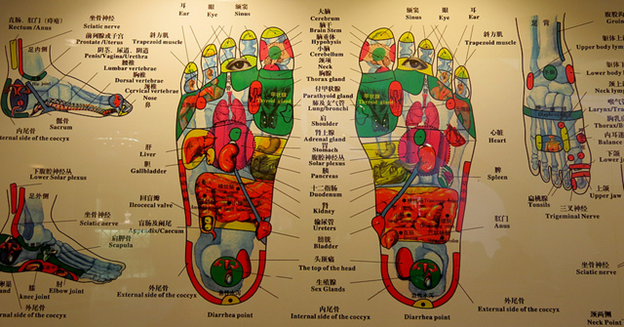Health
The Ultimate Beginner’s Guide To Reflexology
by Polly-Ann Moore
Reflexology is a form of alternative medicine that involves applying pressure to areas of the foot, hand, ear, face or lower leg with the thumb, finger and hand. Read on for our beginner’s guide to reflexology and find out what it is all about.
What Is Reflexology?

Picture Credit: torbakhopper HE DEAD
Reflexologists believe that the different zones and reflex areas on the foot, hand, ear, face or lower leg correspond to different parts of the body. The theory is that by applying pressure and hand techniques to each zone, a physical change occurs to the corresponding area.
For example, the ball of the right foot corresponds to the thyroid/parathyroid glands. The center-point of the foot corresponds to the solar plexus. There is a great map of reflexology areas over at the Cherry Blossom Spa website.
What Does It Treat?
Reflexology is often used for the treatment of many minor conditions. According to practitioners, the therapy helps the body to restore its natural balance, and it can help with tension, relaxation and wellbeing.
A professional reflexologist will not claim to diagnose, prescribe, or cure a condition. But the therapy is often prescribed as a part of an overarching treatment. It has been used to help back pain, irritable bowel syndrome, headaches and migraine, and the menopause.
Does It Work?
It is important to point out that there is not enough evidence to suggest that reflexology can make any clinical claims. If you are ill, you should always seek medical treatment from a doctor first. In general terms, Reflexology should only be used as a complement to your overall treatment.
What Happens In A Treatment?
Therapy sessions will involve you being in a relaxed environment, without shoes or socks. The reflexologist will use their hands to apply pressure to various areas of your feet, hands, lower legs, face or ears, dependent on what you are being treated for.
There can be discomfort at times, but, in general, the experience is said to be very relaxing overall. After the treatment, you will usually be asked to give feedback to the therapist. You may feel a sense of nausea, lethargy or tearfulness, but it is more usual to have a better state of well-being and a relaxed feeling.
Will Insurance Cover It?
In general terms, no. Insurance companies class Reflexology as a physical therapy, and you may have to have specialized insurance to get coverage. However, if you suffer from a specific condition and it is part of a treatment that can be proved to be medically necessary, your doctor may be able to get you an exception.
As an example, let’s say you are a senior with Medicare. If you can persuade your doctor that a treatment is helping you stay fit and well, then you might be able to get some of the costs covered. However, your basic package may not cover it. If so, speak to a specialist advisor first, to find out the best Medicare supplement for you.
We hope this guide has been of use to you. Reflexology is becoming a very popular alternative therapy, and many people have claimed to benefit from a better sense of wellbeing after treatment.
We’d love to hear your thoughts on reflexology, so please share away!




